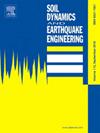Development and characterization of a gravity-well-based triple friction pendulum system
IF 4.2
2区 工程技术
Q1 ENGINEERING, GEOLOGICAL
引用次数: 0
Abstract
Recently, variable stiffness double friction pendulum systems have been extensively studied. Nonetheless, achieving high initial stiffness, softening stiffness during Design Basis Earthquakes (DBE), and subsequent high stiffness during Maximum Considered Earthquakes (MCE) within the limited space of curved surfaces remains a significant challenge. To address this issue, a novel gravity-well-based triple friction pendulum system (GW-TFPS) with adaptable stiffness is proposed. The upper and lower sliding surfaces feature interior spherical geometries with a small radius to enhance self-centering capability, while the exterior surfaces are shaped according to a logarithmic function to ensure reduced stiffness. Additionally, the internal sliding surfaces are spherical with an even smaller radius, ensuring higher stiffness. The friction coefficient of the internal sliding surfaces is larger than that of the top and bottom surfaces to ensure they engage last. The design theory, working mechanism, and restoring force model of GW-TFPS were presented at first. A specimen was fabricated and tested under various vertical pressures to evaluate its characteristics, which were compared with a gravity-well-based double friction pendulum system (GW-DFPS) of identical dimensions. The GW-TFPS not only maintains the superior self-centering and energy dissipation capabilities of the GW-DFPS at small displacements but also exhibits high stiffness at larger displacements, significantly enhancing the system's displacement-limiting capabilities.
基于重力井的三摩擦摆系统的研制与表征
近年来,变刚度双摩擦摆系统得到了广泛的研究。尽管如此,在有限的曲面空间内实现高初始刚度、设计基础地震(DBE)期间的软化刚度以及随后在最大考虑地震(MCE)期间的高刚度仍然是一个重大挑战。为了解决这一问题,提出了一种基于重力井的具有自适应刚度的三摩擦摆系统。上下滑动面采用小半径的内部球面几何形状,以增强自定心能力,而外表面采用对数函数形状,以确保降低刚度。此外,内部滑动面是球形的,半径更小,确保了更高的刚度。内滑动面的摩擦系数大于上、下滑动面的摩擦系数,以保证其持久啮合。首先介绍了gw - tfp的设计原理、工作机理和恢复力模型。制作了一个试样,在不同的垂直压力下进行了测试,以评估其特性,并与相同尺寸的重力井双摩擦摆系统(GW-DFPS)进行了比较。GW-TFPS不仅在小位移时保持了GW-DFPS优越的自定心和耗能能力,而且在大位移时具有较高的刚度,显著增强了系统的限位移能力。
本文章由计算机程序翻译,如有差异,请以英文原文为准。
求助全文
约1分钟内获得全文
求助全文
来源期刊

Soil Dynamics and Earthquake Engineering
工程技术-地球科学综合
CiteScore
7.50
自引率
15.00%
发文量
446
审稿时长
8 months
期刊介绍:
The journal aims to encourage and enhance the role of mechanics and other disciplines as they relate to earthquake engineering by providing opportunities for the publication of the work of applied mathematicians, engineers and other applied scientists involved in solving problems closely related to the field of earthquake engineering and geotechnical earthquake engineering.
Emphasis is placed on new concepts and techniques, but case histories will also be published if they enhance the presentation and understanding of new technical concepts.
 求助内容:
求助内容: 应助结果提醒方式:
应助结果提醒方式:


